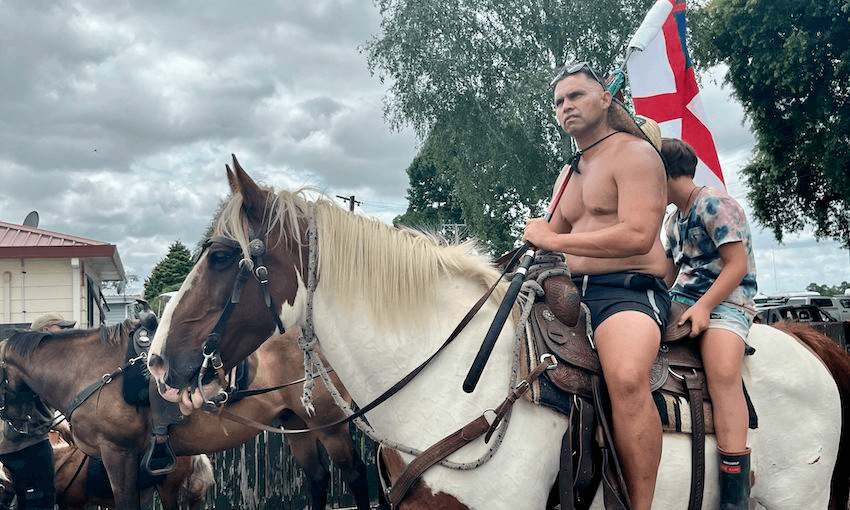Te hui aa motu was a showcase of community mobilisation and cooperation. And one app proved particularly useful.
An efficiently organised pōwhiri saw 10,000 guests through the gates of Tūrangawaewae within half an hour for hui aa motu, the national Kiingitanga gathering, on Saturday morning.
It’s the largest gathering the marae has seen in a day since the tangi of Te Arikinui Dame Te Atiarangikaahu. Guests came from as far as Australia, arriving in buses and cars full of whānau and strangers they’d met for the first time. Black Power and the Mongrel Mob parked up next to one another, helpfully symbolising the overarching kaupapa of kotahitanga. As put by Archbishop Don Tamihere, “you don’t have to like each other to show aroha.”
How did thousands of people even attempt to mobilise to discuss broad topics around national unity within the space of hours without people rarking up or yelling over one another?
The nexus of communication was an unlikely contender: a conference app called Whova that many had not heard of before. Leading up to the hui, te kiingitanga invited potential guests to download the app in order to access the programme of events. Once signed up, guests created groups to “connect a cuzzy”, organise carpools, ask organisers questions, share resources and start the discussion on kaupapa like tikanga, legislation and te reo Māori. During the day, users could access livestreams and generally useful stuff like agendas and maps, as well as post their own photos. Five and a half thousand members later, the Whova app, previously unknown to most, became the unofficial archive of te hui aa motu.
Demonstrating effective organising with the power of social media, the internet and a shared solutions and mokopuna-focused spirit, hui aa motu embodied a version of a public sphere underpinned by aroha and manaakitanga. Though speakers at forums included leaders such as Ta Tīmoti Karetu, Dame Jenny Shipley, Tā Mason Durie, and Dame Hinewehi Mohi, no one was more important than anyone else who had arrived through the gates of the marae. Young people, particularly, were encouraged to share their ideas.
Representing the voices of rangatahi at the plenary, Piripi Winiata (Rongomaiwahine, Ngāti Kahungunu ki Te Wairoa) shared where this tide of energy came from and what support was needed in everyday life, privately and publicly. “Our rangatahi understood the way our pakeke fought for mana motuhake and rangatiratanga,” he said. But noted the fight of rangatahi is different to their elders “ because many of the things you’ve fought for have worked. Many of our speakers have come from kōhanga [and] kura.”
He said because of that, their outlook and their challenges have changed. “The way that we carry the fight forward may look different.”
Winiata and other speakers emphasised the need to decentralise power from the Beehive. Dayle Takitimu (Ngāti Porou, Te Whānau a Apanui, Te Aitanga a Hauiti) addressed the thousands at the pōwhiri: “We have gone to Wellington and we have walked the streets of this whenua to speak truth to power, and we must now have the courage to speak power into our truth.”
Indeed, instead of turning into the “monumental moan session” that Shane Jones forecasted, guests listened attentively, batting fans and meditating on kōrero before asking questions. Around the overflowing forums, attendees ran into old friends and family and rangatahi cooled off in the Waikato River.
For educator Deb Rewiri (Ngāpuhi, Ngāti Awa, Te Whānau-a-Apanui), the hui was “a real celebration of all of us.” She said it was hopeful and uplifting. “You cannot stop the tide from turning its turn and it is really moving on a force of positivity and a force of young voices coming forward.” She thinks these will flow into the coming weeks at Rātana celebrations and Waitangi Day.
“For me, those are the voices of our mokopuna and you cannot stop it.”
The hui was just for one day, but as iwi began their journeys home, connection between attendees, including speakers and hosts of discussion sessions, remain through the Whova app. There, you’ll find “what next” discussions alongside a record of what happened on the day 10,000 people gathered in peace and unity at Tūrangawaewae.



